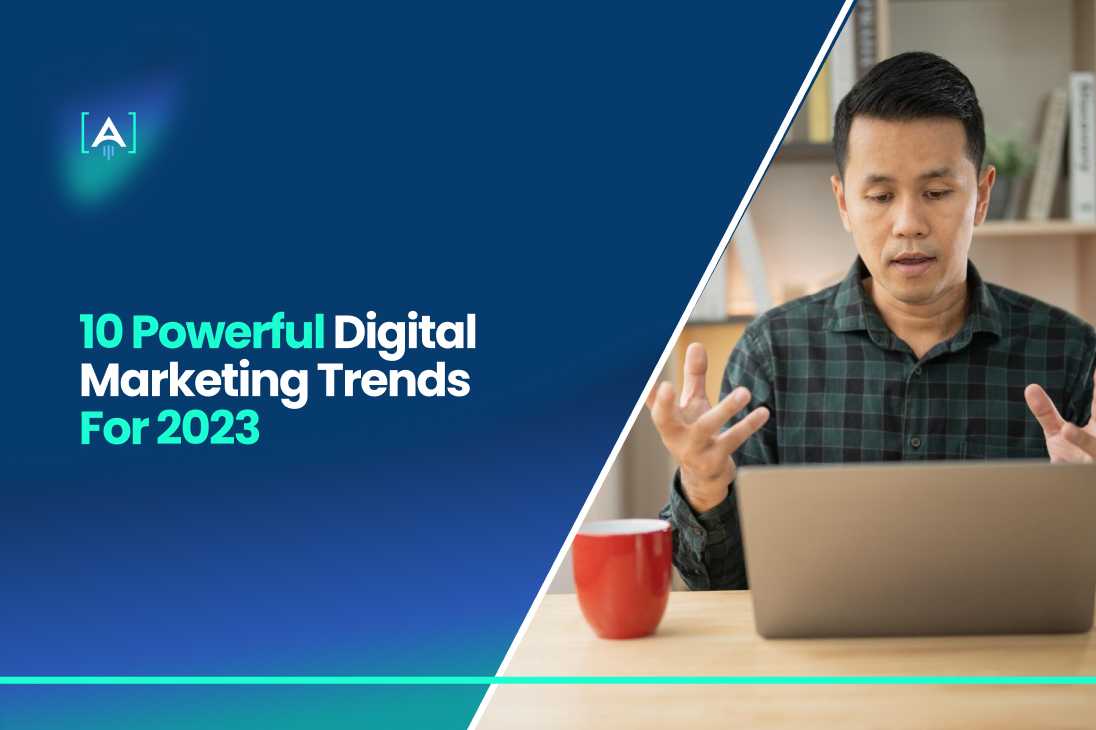The year 2023 is a year of both challenges and opportunities in the digital marketing realm, and it’s vital to stay ahead of the curve. Embracing agility, authenticity, and innovation, your startup cannot only survive but thrive in the expanding universe of digital marketing.
In this comprehensive guide, we delve into the top digital marketing trends of 2023 that are crucial to understand and capitalize on.
We’ll explore how to navigate economic challenges, harness the power of AI-driven tools, and create genuine connections with your audience through social media marketing.
We’ll also discuss the importance of diversifying your marketing channels, collaborating with influencers and content creators, and leveraging new technologies such as the metaverse and gamification.
By mastering these trends and strategically implementing them into your digital marketing strategies, you’ll be well-positioned to create a lasting impact in your industry and drive your startup’s success to new heights.
So let’s dive in and unlock the immense potential that awaits you in the digital marketing landscape of 2023.
Adapting to Economic Challenges and Tech Recession
As a new and growing business, you will likely face various obstacles and uncertainties, from funding and cash flow to market competition and changing customer needs. It’s essential to stay informed about economic trends and have contingency plans to weather unexpected downturns.
At the same time, you need to be nimble and innovative in your technology use, seeking new ways to optimize your operations and stay ahead of the curve. By focusing on flexibility, resilience, and forward-thinking, you can position your startup for success in even the most challenging of circumstances.
When planning your digital marketing strategies, you need to consider each avenue’s cost-effectiveness while ensuring that it still yields quality results.
So how can you be more budget-conscious and still gain maximum ROI?
Budget-Conscious Digital Marketing Strategies
For startups, budget-conscious digital marketing strategies are essential to make the most of your limited resources. One of the most significant areas of cost in digital marketing is advertising spend.
In 2023, digital ad spending has increased by 13.9 %. This has shown us that ad spending has been able to adapt to new trends in the online marketing sphere, where e-commerce and affiliate marketing have taken center stage.
So how can you ensure you’re getting the most out of your ads?
Optimizing Ad Spend
Here are some tips on how to optimize your ad:
- Identify your most profitable keywords
Use tools like Google Ads Keyword Planner to identify the keywords that are most likely to drive conversions for your business. Focus your ad spend on these high-value keywords to get the most bang for your buck.
- Use targeted ad placements
Be selective about where your ads are displayed. Use audience targeting features to ensure your ads are only shown to people who are likely to be interested in your product or service.
- Use ad scheduling
Set up your ad campaigns to run at specific times of day or days of the week when your target audience is most active. This can help you avoid wasting ad spending on periods when your ads are unlikely to be effective.
- Optimize your landing pages
Make sure the landing pages are optimized for conversions. To see which variations perform best, utilize A/B testing to experiment with different layouts, headlines, and calls to action.
- Monitor and adjust your ad campaigns
Keep a close eye on your ad campaigns and adjust your strategies as needed. Use analytics tools to track your results and make more data-driven decisions about where to allocate your ad spend.
Prioritizing High-Impact Channels
Depending on their specific goals and target audience, startups can use several types of high-impact channels in their digital marketing effort, such as:
- Search engine marketing (SEM): SEM includes paid search ads and search engine optimization (SEO) to improve your site’s ranking in search engine results pages (SERPs). This can be a highly effective way to drive targeted traffic to your website.
- Social media marketing: Platforms such as Facebook, Instagram, and LinkedIn offer a range of advertising options that allow you to target specific audiences and track the performance of your campaigns. You can build brand awareness and engage with your audience.
- Email marketing: Email marketing can be a highly effective way to nurture your leads and drive conversions. Use targeted email campaigns to send more personalized messages to your subscribers and track the performance of your campaigns.
- Content marketing: Content marketing involves creating high-quality, engaging content that is designed to attract and retain your target audience. This can include blog posts, videos, infographics, and other types of content.
- Influencer marketing: It involves partnering with social media influencers with large followers to promote your products or services. This can be a highly effective way to build brand awareness and drive conversions among your target audience.
By using a combination of these high-impact channels and monitoring their performance closely, businesses can optimize their digital marketing efforts and achieve their goals more efficiently and effectively.
Here are some steps to follow to identify and prioritize the channels that will have the most significant impact on your business:
- Define your goals
Start by defining your business goals and the specific outcomes you want to achieve through your digital marketing efforts. This could include things like generating leads, driving website traffic, increasing brand awareness, or boosting sales.
- Understand your audience
Use audience research tools to gain insights into the characteristics and behaviors of your target audience. This information can help you determine which channels will most likely reach and engage your audience.
- Analyze past performance
Look at the performance of your past marketing campaigns to identify which channels have been most effective in achieving your goals. Use this information to inform your future marketing strategies.
- Experiment with new channels
Consider testing out new channels or platforms to see if they have the potential to be high-impact. Start with small-scale experiments and use analytics tools to measure the results.
- Monitor and adjust your strategies
Keep a close eye on the performance of your digital marketing channels and adjust your strategies as needed. Use analytics tools to track key metrics like click-through rates, conversions, and return on investment (ROI).
The Role of Work Management Platforms

Work management platforms can be especially beneficial for startups, where resources and time are often limited. Here are some ways in which startups can benefit from using work management platforms:
- Collaboration: Startups often have small teams that must work closely to achieve their goals. Work management platforms provide a centralized location for teams to collaborate and communicate effectively, even if team members are working remotely.
- Project management: With many projects and initiatives going on simultaneously, work management platforms can help startups manage these projects efficiently, prioritize tasks, and meet deadlines.
- Task management: Limited resources shouldn’t impede your goals. Though you must ensure your team members are working on the most critical tasks at any time. Work management platforms can help you manage your workload and ensure your team is focusing on the tasks that will have the most impact.
- Workflow automation: Being nimble and adapting quickly to changing circumstances are desired traits in the startup world. Work management platforms can help you automate repetitive tasks and streamline workflows, allowing you to be more agile and responsive.
- Analytics and reporting: Keeping track of your performance and making data-driven decisions is vital. Work management platforms can provide you with the data and analytics you need to measure your progress, identify areas for improvement, and optimize processes.
Wrike as a solution for digital marketers
Wrike is a cloud-based work management platform that enables teams to collaborate, manage projects, and streamline workflows. It offers a range of features that can be particularly beneficial for digital marketers, including:
Task Management and Collaboration
It allows teams to create, assign and collaborate on tasks, set deadlines, and track progress. Users can also organize tasks into folders, projects, or workflows.
Time Tracking
It has a built-in time tracking feature that allows users to track the time they spend on tasks, which can help with project management and billing.
Custom Workflows
It allows users to create custom workflows to match their team’s unique processes, ensuring that projects are completed efficiently and accurately.
Reporting
It provides detailed reports that can be used to track team performance, project progress, and overall productivity.
Integrations
It integrates with a variety of other tools, including Slack, Google Drive, and Salesforce, allowing teams to streamline their workflow and increase productivity.
Overall, Wrike can be a powerful solution for digital marketers who must manage multiple projects, collaborate effectively with team members, and optimize their workflows.
App Consolidation and Efficiency
If you’re looking to implement app consolidation, here are some steps you can take:
- Conduct an app audit: Start by conducting an audit of the apps and tools the startup uses. This can help identify redundancies and inefficiencies.
- Identify critical apps: Determine which apps are critical to the business and which can be consolidated or eliminated.
- Evaluate app integrations: Look for apps that can be integrated into a single platform, such as project management, communication, and productivity tools.
- Consider workflow processes: Analyze the startup’s workflows and processes to identify areas where app consolidation can be most effective.
- Train employees: Train employees on using the consolidated platform and communicating the new system’s benefits to ensure everyone is on board.
- Monitor and adjust: Monitor the new system’s effectiveness and adjust as needed to ensure optimal efficiency and productivity.
Startups can also consider using a work management platform like Asana, Trello, or Monday.com, which provide an all-in-one solution for managing projects, communication, and collaboration. These platforms offer integrations with other tools and apps, allowing businesses to consolidate their workflows and reduce the number of apps they need to manage.
The Rise of Shorter Video Content and AI-driven Tools

Over the past few years, we’ve seen a surge in the popularity of shorter video content and AI-powered tools.
Shorter videos, clocking in at under 60 seconds, have taken the digital world by storm due to their impressive ability to immediately grab viewers’ attention and communicate information with precision.
The best part?
With cutting-edge AI-driven marketing tools, like video editing software, producing captivating and high-quality video content has never been easier.
Now let’s take a peek at some examples
Short-form Video Platforms
Short-form video platforms such as Instagram Stories, Reels, TikTok, and LinkedIn video content have become increasingly popular in recent years.
These platforms have a number of benefits for startups looking to create engaging content and connect with their audience.
Instagram Stories and Reels:
These short-form video features on the Instagram platform are the perfect way for businesses to create engaging content that disappears after just 24 hours.
With Reels, businesses can add music, transitions, and other effects to create show-stopping short-form videos that are sure to capture attention.
Plus, both Instagram Stories and Reels offer a fun and creative way for startups to showcase their brand, products, and services and engage with their audience. So don’t miss out on this amazing opportunity to connect with your followers and stand out in the digital crowd.
TikTok:
TikTok is a video-sharing social media platform that’s been popular particularly among younger generations.
A digital marketing trend that’s hard to ignore, with its short-form videos, music, and special effects, TikTok offers businesses an opportunity to create engaging and viral content that can help to increase brand awareness and reach a younger audience.
TikTok’s algorithm also favors engaging content with a high watch time, which can help startups gain traction quickly.
LinkedIn video content:
With its captive audience of professionals and business leaders, LinkedIn provides the perfect platform for businesses to showcase their industry expertise and highlight their products, services, and company culture.
With LinkedIn video content, startups have the power to build trust with their audience and position themselves as leaders in their field.
ChatGPT in Digital Marketing

Looking for a powerful tool to enhance your communication and boost your productivity?
Say hello to ChatGPT, the language model trained by OpenAI that can help you streamline your workflow, answer your burning questions, and take your online interactions to the next level!
This new digital marketing trend can help improve user engagement and understanding of the content, ultimately leading to better business results.
However, it’s also essential for businesses to consider ethical considerations when using language models like ChatGPT.
One potential issue is the risk of bias in the training data used to develop the model, leading to biased results and perpetuating existing social inequalities. Businesses must ensure that their use of ChatGPT and other language models is ethical and responsible and that they are actively working to mitigate any potential biases.
For example, if a language model is trained on text from predominantly male authors, it may produce biased results when generating content related to gender issues. Similarly, if the training data is biased towards a particular race or ethnicity, the resulting model may also produce biased results related to race and ethnicity.
That’s why research and editing are both necessary when creating content for your audience. Your solid content team must ensure that all the generated information aligns with your business goals and stands out from the crowd.
Diversifying Social Media Channels and Building a Tight Martech Stack

According to Statista, social media ad spend is expected to reach $268.7 billion in 2023.
So diversifying social media channels is one digital marketing strategy that can help startups reach a wider audience and increase engagement.
By leveraging various social media channels and building an efficient Martech stack, startups can achieve better results and grow their business more effectively.
Expanding Social Media Presence
Expanding social media presence involves posting regularly, decentralizing campaigns across multiple platforms, and identifying platform-specific opportunities.
- Decentralizing campaigns
This refers to spreading your efforts across multiple social media platforms instead of focusing solely on one or two. Each platform has a unique audience and user experience, so diversifying your efforts can help you reach a broader audience and increase engagement.
- Identifying platform-specific opportunities
This means tailoring your content and strategy to each platform. For example, Instagram is highly visual and famous for influencer marketing, so a startup may focus on creating visually appealing content and partnering with influencers on the platform.
Conversely, LinkedIn is more geared towards professional networking and thought leadership, so a startup may focus on sharing industry insights and engaging in meaningful discussions with other professionals.
Effective Martech Stack Strategies
In today’s fast-paced digital landscape, having a solid Martech stack strategy is the key to success for businesses looking to thrive in the market.
A well-executed Martech stack can help you enhance your customer engagement, streamline your operations, and skyrocket your revenue.
Effective martech stack strategies involve seamless integration, collaboration, and data-driven decision-making.
- Seamless integration and collaboration
This refers to the ability of different martech tools to work together seamlessly and facilitate collaboration between different teams and departments.
For example, a CRM tool may integrate with a marketing automation tool to enable better lead management and conversion tracking. With a tight martech stack, startups can streamline their processes and improve their efficiency, leading to better results.
- Data-driven decision-making
This refers to the practice of making decisions based on data and insights rather than intuition or assumptions. A robust martech stack can provide valuable data and insights that startups can use to make informed decisions about their marketing strategy.
For instance, analytics tools can provide data on website traffic and user behavior. In contrast, A/B testing tools can help startups test different variations of their campaigns and identify the most effective approach.
Collaborations with Influencers and Content Creators

Did you know that the influencer market size in 2022 was valued at 16.4 billion dollars in the US?
And it’s only expected to grow further in the coming years.
Still have doubts about investing in it?
Collaborations with influencers and content creators can help startups expand their reach and attract new audiences.ad
When working with influencers and content creators, it’s essential to establish clear goals and expectations upfront to ensure a successful partnership.
Plus, authenticity and transparency are critical factors in building a strong and sustainable collaboration with influencers and content creators.
In recent years, the importance of influencers has grown tremendously, particularly in the world of social media. One of the main reasons for this is influencers’ perceived authenticity and relatability. As traditional advertising methods have become less effective, companies have turned to influencers to promote their products and services.
- Authenticity and relatability
Authenticity is a critical factor in the success of influencers. Many people are tired of traditional advertising that feels forced or disingenuous and appreciate the authenticity of influencers who share their experiences and opinions. Influencers are often seen as more trustworthy than traditional celebrities or advertisements because they are perceived as being more genuine and relatable.
Relatability is also essential in the world of influencers. Many people follow influencers they feel they can relate to or share similar values and interests. This can include everything from fashion and beauty to fitness, food, and travel.
- The rise of the creator economy
As the importance of influencers has grown, so too has the creator economy. The creator economy refers to the growing number of individuals who are able to make a living from creating content online. This includes influencers but also includes other creators such as bloggers, podcasters, and YouTubers.
- Aligning brand values and messaging
Successful brand and creator partnerships are often the result of aligning brand values and messaging. When a brand partners with an influencer or content creator who shares its values and message, it can lead to a more authentic and effective campaign.
For example, if a sustainable fashion brand partners with an influencer who is passionate about environmental issues and promotes eco-friendly lifestyle choices, the partnership will likely resonate more strongly with its audience. This alignment of values and messaging can create a more authentic and effective partnership.
- Navigating the global cost of living crisis
As the cost of living continues to rise around the world, many influencers and creators are looking for ways to monetize their content and earn a living. Brands that are able to offer fair compensation and support to their partners are more likely to build long-term and successful partnerships.
At the same time, brands need to be mindful of their budgets and ensure that they are getting a return on their investment. This can involve careful planning and negotiation to ensure that both parties are able to benefit from the partnership.
Prioritizing Human Content and Authenticity

Conversational marketing is the key to achieving success in 2023. People want to connect with brands on a more human level, so creating meaningful relationships and fostering genuine engagement is essential.
One way to do this is by providing personalized, humanized content that truly resonates with your target audience.
Meeting Audience Needs and Expectations
Quality content creation
It all starts with producing top-notch, valuable, and engaging content. From in-depth articles and jaw-dropping videos to stunning photos and graphics, there’s no limit to what you can achieve with quality content. By creating content that truly resonates with your audience, you’ll not only attract new followers but also keep them coming back for more.
So why settle for mediocre content when you can stand out from the crowd with high-quality, impactful creations?
Audience-first approac
Ready to captivate your audience and take your content to the next level?
It all starts with an audience-first approach! By truly understanding the needs and interests of your target audience, you can tailor your content to meet their expectations and exceed their wildest dreams.
This means going above and beyond to conduct research, engage with your followers on social media, and gather insights on their preferences and feedback. By putting your audience’s needs first, you’ll build a loyal following that trusts and values your content.
So why wait? Embrace the power of an audience-first approach today and watch your content soar to new heights!
This can involve conducting research and engaging with the audience through social media and other channels to gain insights into their preferences and feedback.
Balancing AI-Generated Content and Human Touch
Sure AI can be a game changer in the content arena, but don’t forget you’re entertaining the attention of humans.
Repetitive content can bring down views and drive your customers away once they realize there’s no real effort behind all that information.
After all, if they can get the same information from Google what’s the point in engaging with your content?
To ensure authenticity and relatability, creators need to strike a balance between AI-generated content and human touch. This involves using AI and technology to assist in content creation while also infusing a human touch into the process.
- Ensuring authenticity and reliability
One way to achieve this balance is to use AI and technology for tasks such as research and data analysis while reserving the creative and personal aspects of content creation for human input. This can help ensure that the content has a genuine and relatable voice while also leveraging the efficiency of AI and technology.
- Emphasizing genuine connections
This involves creating content that fosters genuine connections and relationships with the audience rather than simply promoting products or services.
To emphasize genuine connections, creators can focus on creating informative, entertaining, and engaging content while also being authentic and relatable. This can include sharing personal stories, experiences, and insights that resonate with the audience and actively engaging with them through comments and social media channels.
Proving ROI and Embracing Paid Advertising for Growth

By measuring the return on investment regarding revenue, customer acquisition, and engagement metrics, you’ll be able to demonstrate the true value of your content marketing efforts and secure the budgets and resources you need to take your strategy to the next level.
From boosting revenue to increasing customer engagement, proving ROI is critical to success in the world of content marketing.
Here’s how you can achieve this
Measuring and Analyzing Content Marketing Results
Measuring and analyzing content marketing results is essential for determining the effectiveness of a content marketing strategy and making data-driven decisions to improve it.
- Multi-step or linear attribution models
Two standard methods for measuring content marketing results include multi-step or linear attribution models and click-through rates (CTR) over rankings.
Multi-step or linear attribution models involve tracking the entire customer journey, from initial contact to final conversion. This allows marketers to see how different touchpoints along the customer journey contribute to the final conversion rather than just focusing on the last interaction before the conversion. You can get a more accurate understanding of which content and channels drive conversions and help optimize the overall content marketing strategy.
- Click-through rates over rankings
These focus on the effectiveness of individual pieces of content in driving traffic to a website. This involves tracking the number of clicks a particular piece of content receives compared to its ranking in search results. You can gain insights into how well your content is performing in driving traffic to the website and can help optimize content to improve its ranking and click-through rate.
Investing in Paid Advertising Tactics
Don’t let a low budget stop you from gaining attention online.
Investing in paid advertising tactics can be an effective way to reach a wider audience and drive growth. Two popular forms of paid advertising are social media advertising and native ads, and sponsored content.
- Social media advertising
This involves creating and promoting content on social media platforms, such as Facebook, Twitter, and Instagram, using paid advertising tools. Social media advertising allows businesses to target specific audiences based on demographics, interests, and behaviors. This can be especially effective for reaching younger audiences, who are often active on social media.
- Native ads and sponsored content
These include promoting content in a way that blends in with the format and style of the platform it appears on. This can include sponsored posts on social media, sponsored content on websites, and promoted listings on search engines. Native ads and sponsored content can be a less intrusive way to promote content, as they appear more natural and less like traditional advertisements.
Exploring New Opportunities in the Metaverse and Gamification

The virtual world isn’t part of our imaginations anymore. It’s here!
Discovering the metaverse and gamification opportunities can be a promising avenue to engage with consumers in new and innovative ways.
The metaverse is an emerging digital realm where users can interact with each other and with digital objects in a shared virtual space. As this technology continues to develop, it presents new opportunities for digital marketing.
Immersive Virtual Communication and Developing Metaverse-specific Strategies
Imagine giving your users the chance to interact with your products or services in ways they never thought possible.
That’s the power of metaverse marketing. But that’s not all – you can also leverage social media channels and influencers within the metaverse to promote your brand and drive engagement like never before.
So why wait? Start developing your metaverse-specific strategies and get ready to take the marketing world by storm!
The metaverse presents a new frontier for digital marketing, offering endless possibilities for immersive experiences that can create deep emotional connections with consumers.
As technology continues to advance, brands and businesses will need to stay up to date with metaverse-specific strategies to leverage this exciting new medium to its full potential.
Gamification in Digital Marketing

Who isn’t entertained by playing games?
Answer: No one
While it depends on the games themselves and how people choose ones that they enjoy, transforming new product releases into quizzes on social media can go a long way in gaining new audience groups.
Gamification in digital marketing is using game elements to engage users and enhance customer experience, retention, and loyalty.
- Engaging users through game elements
By adding elements of competition and achievement, gamification can make the user experience more enjoyable and motivating.
For instance, if you sell sports equipment, you could create a game that challenges users to hit a target or score a goal using your products. To make the game more engaging, you could add elements like leaderboards, badges, and rewards for completing certain tasks or achieving certain milestones.
You could also incorporate social sharing features that allow users to share their scores or achievements with their friends and followers on social media, further boosting brand awareness.
- Enhancing customer experience and retention
One key benefit of gamification in digital marketing is its ability to enhance customer experience and retention.
For instance, you could create a loyalty program that rewards customers with points for making purchases, sharing content on social media, leaving reviews, or referring friends to your brand. These points can then be redeemed for rewards like discounts, free products, or exclusive experiences.
The Continued Growth of Podcasts and Audio Content

With their ability to cover a wide range of topics and formats, from true crime to self-help to comedy, podcasts have become a go-to medium for people looking to learn, laugh, and be entertained.
So, what makes podcasts so appealing, and why should you consider adding them to your media diet?
Podcasts As a Storytelling Medium
Podcasts have emerged as a powerful storytelling medium, allowing brands to connect with always-on consumers in a more intimate and engaging way.
Connecting with always-on consumers
Unlike other forms of content, podcasts can be consumed while on the go, making them a popular choice for busy consumers who are looking for ways to make the most of their time. Additionally, podcasts are available on a wide range of platforms, making them accessible to a broad audience.
Building brand awareness and loyalty
Through engaging storytelling, podcasts can provide a window into a brand’s culture, values, and mission, which can help to build trust and loyalty with listeners.
Opportunities in Audio Marketing

From a marketing perspective, optimizing for voice search has become a critical strategy for businesses looking to reach consumers where they are and capitalize on this emerging trend.
- Voice-based search optimization
This can involve using conversational language, focusing on long-tail keywords, and providing concise and helpful answers to common questions. By optimizing for voice search, you can improve visibility and reach a growing number of users who prefer to use voice assistants to find information and make purchasing decisions.
With the rise of smart speakers and virtual assistants like Amazon’s Alexa and Google Assistant, consumers increasingly use voice-based search to find information and purchase.
- Audio ads on popular platforms
Another critical opportunity in audio marketing is using audio ads on popular platforms like Spotify, Pandora, and SoundCloud. These platforms offer a highly targeted and engaged audience, with users spending an average of 148 minutes daily listening to audio content. By creating compelling and relevant audio ads, brands can effectively reach their target audience and drive awareness, consideration, and conversion.
Embracing User Privacy and New Marketing Solutions
Giving out phone numbers might be part of the norm nowadays, but people are still cautious about sharing private information on websites.
That’s why startups should be mindful when advertising their services, and make sure to keep the collection and use of personal data in line with regulations.
And with regulations constantly changing, how can you ensure that you’re doing your part in keeping users safe on the net?
Adapting to Changing Privacy Regulations
With the rise of privacy concerns, cookieless advertising, and privacy-first marketing strategies have become important ways to adapt and thrive in this changing landscape.
- Cookieless advertising
This refers to the practice of serving ads without using third-party cookies, which are small pieces of data stored in a user’s browser that track their browsing behavior across websites. With many web browsers phasing out support for third-party cookies, startups are turning to alternative methods, such as contextual advertising or first-party data, to reach their target audience.
- Privacy-first marketing strategies
This prioritizes user privacy by giving users control over their data and being transparent about how their data is being collected and used. It includes obtaining explicit consent before collecting personal data, implementing clear privacy policies, and allowing users to opt out of data collection.
Innovative Marketing Approaches
These approaches are essential for startups to stand out in a crowded market and capture the attention of their target audience.
- Account-Based Marketing for B2B
This is a type of B2B marketing strategy focusing on targeting high-value accounts rather than broad audiences. This approach involves tailoring marketing efforts to specific accounts and decision-makers, which can lead to higher engagement and conversion rates.
- Augmented reality and phygital experiences
AR allows customers to interact with virtual objects in a real-world environment, while phygital experiences blend physical and digital elements to create an immersive experience.
- Q-commerce and the future of online ordering
Q-commerce, or quick-commerce, is a growing trend in the e-commerce industry that provides customers with fast and convenient online ordering and delivery options. This includes features such as one-click ordering, instant checkout, and same-day delivery. By leveraging Q-commerce, startups can provide a frictionless and convenient shopping experience that meets the expectations of modern consumers.
The Evolving Landscape of B2B Digital Marketing
If you want to sell to a business directly, how can you ensure you reach the right decision-makers?
With new ways to market and sell online, you can reach the right decision-makers without spending a lot of time researching.
Here’s how!
Video Content in B2B Marketing

Video content has become an increasingly popular format in B2B marketing, providing a more engaging and immersive way for businesses to communicate with their target audience. Two common types of video content used in B2B marketing are webinars and product demos.
- Webinars and product demos
These are online events that allow businesses to connect with their audience in real time, providing an opportunity to share knowledge, insights, and industry trends. Webinars can be used to generate leads, build brand awareness, and establish thought leadership within a specific industry.
Product demos are another type of video content that is widely used in B2B marketing. These videos showcase the features and benefits of a product or service, providing potential customers with a better understanding of how it works and how it can help them solve a particular problem. They can be used in various sales funnel stages, from generating awareness to closing deals.
- Thought leadership and expert interviews
These are also effective types of video content in B2B marketing. By showcasing the expertise and knowledge of company leaders or industry experts, businesses can establish themselves as thought leaders within their industry, building trust and credibility with their target audience.
Social Selling and B2B Engagement
Social selling and B2B engagement are the perfect pair to boost your business’s bottom line. By leveraging social media platforms and engaging with potential clients, you can build meaningful relationships that drive sales and establish your brand as a leader in the industry.
- LinkedIn as a platform for sales and marketing
With over 740 million users, LinkedIn offers a vast network of professionals to target and engage with.
By leveraging LinkedIn’s search tools and advanced filters, businesses can identify and reach out to prospects who match their ideal customer profile. It also allows businesses to join groups and communities within their industry, providing an opportunity to engage with potential customers and establish thought leadership.
- Building connections through curated content
By sharing relevant and informative content, businesses can position themselves as experts within their industry and build trust with their audience. Additionally, curated content can help to establish a strong brand identity and differentiate a business from its competitors.
Brands Embracing Social Responsibility and Accountability
More and more brands are embracing social responsibility and accountability as core aspects of their business strategy, recognizing the importance of taking a stand on social and environmental issues.
Aligning with Social Causes and Values
Startups that align with social causes and values can differentiate themselves from their competitors and attract customers who prioritize social responsibility in their purchasing decisions.
- Transparency and authenticity in messaging
Transparency allows businesses to demonstrate their commitment to social responsibility and accountability. This can involve being open and honest about a company’s practices and policies and actively communicating about social and environmental issues that are important to the brand.
Authenticity is another critical factor in connecting with values-driven consumers. Consumers can often spot insincere or opportunistic attempts by businesses to align with social causes and values. Therefore, startups should ensure that their messaging is genuine and reflects their core values and beliefs.
- Connecting with values-driven consumers
To effectively connect with values-driven consumers, startups should focus on messaging that reflects their commitment to social responsibility and accountability while also being transparent and authentic. This could be, for instance, a sustainable fashion brand that promotes eco-friendly practices and ethical sourcing. By sharing their values and mission through social media and other marketing channels, they can attract consumers who prioritize sustainability and ethical practices in their purchasing decisions.
Sustainable and Ethical Marketing Practices
All talk and no action can lead to a negative profit margin.
Claiming that one supports a cause is only half of the job. What about true implementations and proofs of commitment?
These can be done in the following ways:
- Environmentally friendly campaigns
These can take many forms, such as promoting sustainable products or reducing waste in production and distribution. Businesses can also adopt sustainable practices in their marketing materials, such as using recycled paper or digital formats. By doing so, businesses can demonstrate their commitment to protecting the environment and appeal to customers who prioritize sustainability in their purchasing decisions.
- Ensuring fair labor and supply chain practices
Businesses can ensure fair labor practices by providing safe and healthy working conditions, fair wages, and opportunities for career advancement. Additionally, businesses can implement ethical supply chain practices by sourcing materials from suppliers that prioritize sustainability and social responsibility.
Personalization and Anticipation Marketing

Personalization and anticipation marketing are two powerful strategies enabling businesses to create more engaging and relevant customer experiences.
Tailoring content to individual users
- Personalized recommendations and offers
By using data analysis and machine learning algorithms, businesses can predict what products or services a customer might be interested in and proactively offer them. This anticipation marketing strategy can help businesses create a more seamless and personalized customer experience, leading to increased customer loyalty and retention.
- Segmentation and targeting strategies
These involve grouping customers based on shared characteristics, such as demographics, interests, and behaviors. By doing so, businesses can tailor their content to each group’s unique preferences and needs. For example, an e-commerce business might use segmentation and targeting to offer personalized product recommendations to customers based on their past purchases and browsing history.
Predicting and addressing user needs
- Anticipation marketing techniques
These techniques involve predicting and addressing user needs before they even realize it, creating a seamless and personalized customer experience.
- Utilizing data and analytics for better insights
Startups can also utilize customer feedback and surveys to gain insights into their needs and preferences. This information can be used to make improvements to the customer experience and address pain points before they become a problem.
Content Optimization for Voice Search and Assistants

We talked about optimizing voice search for ads, but what about for content?
Trends are ever changing in this area and keeping up with the latest news and updates is a must if you plan on implementing this feature.
Adapting to voice search trends
This involves understanding user intent and natural language and adapting content to match how people speak and ask questions.
- Optimizing content for voice queries
To optimize content for voice search, startups should begin by identifying the types of questions and queries that their target audience is likely to ask. This can involve analyzing search query data and conducting customer research to understand common pain points and questions.
Once these have been identified, they can begin to optimize their content to match the natural language and phrasing used by their audience. This may involve using long-tail keywords and phrases, as well as structuring content in a way that answers common questions directly.
- Understanding user intent and natural language
In many cases, voice search users are looking for quick and concise answers to specific questions. By understanding the intent behind these queries, startups can create content that is more likely to satisfy the user’s needs and provide a positive user experience.
Engaging with voice assistants and smart speakers
Engaging with voice assistants and smart speakers requires startups to think creatively about how they can provide value to users through voice-based interactions
- Developing brand-specific voice skills
Voice skills can take many forms, from simple skills that provide information or answer questions to more complex skills that allow users to interact with a brand’s products or services. For example, a startup in the fitness industry might create a voice skill that provides users with daily workout routines, while a startup in the food industry might create a voice skill that provides users with recipe ideas and cooking tips.
- Audio ads and voice-based interactions
Startups can also create audio ads that are explicitly designed for voice-based interactions. These ads can take advantage of the unique capabilities of voice assistants and smart speakers, such as natural language processing and personalized recommendations. By creating audio ads that are relevant, engaging, and useful to users, startups can build brand awareness and drive conversions.
The Importance of Mobile-First Strategies in Digital Marketing
With 80 years old people scrolling with one thumb and little ones as young as 5 watching cartoons, no one can deny the power of smartphones these days.
Mobile devices continue to be the primary way that consumers access the internet and engage with brands. And brands should take advantage of this in a heartbeat by optimizing their sites.
Mobile optimization and responsive design
Startups need to ensure that their websites and content are optimized for mobile consumption.
- Ensuring seamless user experience on mobile devices
This involves ensuring fast load times, easy navigation, and clear calls-to-action that are optimized for touch-based interactions. Startups should also prioritize mobile-friendly content formats, such as short-form videos, vertical images, and concise copy that is easy to read on a small screen.
- Adapting content for mobile consumption
Mobile devices offer a range of targeting and personalization capabilities, such as location-based targeting and push notifications. By leveraging these capabilities, startups can create highly personalized and relevant mobile experiences that drive engagement and conversions.
Mobile marketing techniques and channels
Startups have a range of techniques and channels at their disposal to reach and engage with their audiences.
- SMS and mobile messaging campaigns
To leverage these types of campaigns, startups should build and segment their mobile subscriber lists and use automation and personalization tools to create highly relevant and timely messages. They should also prioritize opt-in and opt-out processes to ensure compliance with relevant regulations and maintain trust with their audiences.
- Location-based marketing and geofencing
This can be especially effective for businesses with physical locations, such as retailers or restaurants, who want to drive foot traffic and local awareness.
With location-based marketing, startups can target customers based on their proximity to a specific location, such as a store or event venue. This can be done through various channels, including mobile ads, push notifications, or even augmented reality experiences.
Geofencing takes this a step further, allowing startups to create virtual boundaries around specific locations and trigger specific actions when a customer enters or exits that boundary. For example, a startup might use geofencing to send a special offer or promotion to customers who are near one of their stores.
The Future of Digital Marketing: Agility and Adaptability
Marketers are regularly taught to think outside the box, and this phrase doesn’t fall only on them, but also the owner of the business and the entire team. Having such an innovative way of thinking, gives you a competitive edge in the market and makes your business stand out from others.
Keeping up with emerging trends and technologies
- Staying informed and proactive in a rapidly changing landscape
One key to staying ahead of the curve is to invest in ongoing education and training for digital marketing teams. This can take the form of attending industry events and conferences, participating in online courses and webinars, or even setting up regular knowledge-sharing sessions within the team.
- Constantly refining and updating digital marketing strategies
Startups must be prepared to pivot quickly in response to changing consumer behaviors or market conditions. This requires a mindset of flexibility and agility and a willingness to experiment and take risks.
Mastering the Digital Marketing Landscape of 2023 – Agility, Authenticity, and Innovation

In the fast-paced world of digital marketing, startups that are agile, authentic, and innovative will be the ones to make a lasting impact in 2023.
By staying on top of the latest digital marketing trends and technologies, you can unleash your full potential and stand out from the crowd with ethical and sustainable marketing practices.
With emerging marketing approaches like account-based marketing and augmented reality, you can create unique and engaging experiences that captivate audiences and drive sales. Moreover, by adapting to voice search and mobile marketing trends, you can tailor content to individual users and create authentic connections that build brand loyalty.
So, whether you’re a budding entrepreneur or an established startup, now is the time to embrace the digital marketing landscape and take your brand to new heights!


